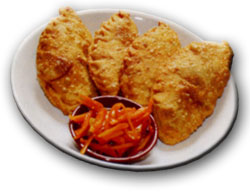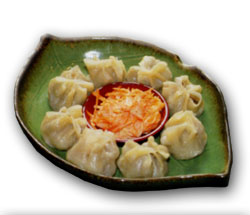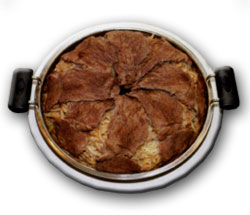Food of the Mongolian nomads
INFORMATION FOR TRAVELERS
THE TRADITIONAL CUISINE MONGOLIA
NOMADS CUISINE

Food and diet are an integral part of the Mongolian culture, which takes its
origin from Huns' time. The stories about Mongolian traditional cuisine probably
will dispel one's perception that "Nomadic people in Mongolia eat only meat
after de-sectioning a carcass meat to bone ratio and boiling it."
Anyone will agree that cuisine or dish of any nation has close relation to the
richness of their culture, nature and geography and practice of earning for
living. Mongolian traditional cuisine has been enriched with cooking tradition
of many other nations which is tracked with history of the nation 800 years ago,
the time of the conquest. As a result of the conquest, which led to rapid
culture exchange and integration of nations Mongolia was quick to embrace
cuisines from other parts of the world.
That is why today Mongolia is a country with a rich cuisine which combines and
presents cuisine of many other nations.
Today, in Ulaanbaatar one can easily find a place to eat cuisine of any nation,
since 60 restaurants of over 20 countries operate in Ulaanbaatar.
Mongolians have developed many different strict techniques of preparing and
cooking food. Let me share with you an interesting story about the techniques of
slaughtering an animal. Uguudei, one of the Chinggis Khaan's sons ordered to
slaughter an animal by slitting the belly and yanking the vena cava. Since then
Mongolians use this technique to have the most nourishing and nutritious meat.
Mongolians do not eat meat all year around. Traditionally, for their choice of
food Mongolians used to take into the consideration what season and how healthy
was the food for that particular time. In the severe winter, they regularly
consume highly nutritious reserved meat rich with protein and fat to allow them
to keep their warmth and stay strong. However, during the harsh spring, they do
not slaughter an animal for food but prefer to consume borts (dried meat),
hyaramtsag (frozen in the casing blood and other by products), uuts (preserved
meat) and shuuz (preserved meat in its own sauce) and prepare their stomach for
the warm summer time. In the summer, they do not eat meat at all, often consume
dairy products only. When the weather cools down with the start of the autumn,
ripened wild berries, vegetables and grain and wheat come to the menu.
This time I would like to bring you to the traditional cooking of Mongolia. The
restaurant "Modern Nomads" shares their menu with you.
Like Americans love Coca Cola, and Russians kvass, the most favorite drink of
Mongolian people is airag, self-fermented Mare's milk, which is considered to be
cream of all food and drink. This is a whole milk curdled to beverage or
custard-like consistency by lactic-acid-producing microorganism. Best time for
airag fermenting is the autumn time, not only because of the warmth but also due
to the grass and herbs the animal eat. One who tried airag in autumn time will
remember the taste-refreshing, but a bit sour. It can not be confused with the
milk we add into a tea. Mongolians consume the tea, which was described by Marco
Polo, a great traveler, that "he felt this drink was I ike an ordinary drink but
left him filled as if he had eaten a light, but nutritious meal" When you come
to any family, the first thing you are offered is a tea. Mongolians make
different types of drinks with milk, varying in milk content in it, such as
hyaram (boiled water with a small portion of milk to make it look not creamy but
milky), tsiidem (boiled water with even smaller amount of milk to make it look
watery, rather than milky).
Let us now move to the menu. It should be pointed that the recent years
restaurants have stopped to offer fat dish as the customers have become
conscious about the harmful ness of an excess fat and are paying attention to
cook daily traditional menu with lessfat.
|
 1.
Huushuur: (Cornish pasties-like, deep fried flat dumpling stuffed with meat)
with garnish: Russia and China are two big neigh bors.withwhichthe country had
great extent of exchange and some infl uence on our culture. It is said thatthis
dish originates from China, but it is known that this stuffed meat had been
popular in Mongolia from very early time. Minced or chopped meat is seasoned
with onion, other spices or flavoring ingredients. If one finds huushuur with
garnish in the menu, you can have 4-5 hot huushuur arranged with some salad or
starters. The meat produces a lot of juice, as being stewed. 1.
Huushuur: (Cornish pasties-like, deep fried flat dumpling stuffed with meat)
with garnish: Russia and China are two big neigh bors.withwhichthe country had
great extent of exchange and some infl uence on our culture. It is said thatthis
dish originates from China, but it is known that this stuffed meat had been
popular in Mongolia from very early time. Minced or chopped meat is seasoned
with onion, other spices or flavoring ingredients. If one finds huushuur with
garnish in the menu, you can have 4-5 hot huushuur arranged with some salad or
starters. The meat produces a lot of juice, as being stewed.
Recipe: Divide the pastry into small round pieces and roll them in an
appropriate thickness. Before this, minced meat is seasoned. Then place a thin
layer of the prepared meat on the one half of the pastry, be careful not to have
too much filling which would cause the pastry to burst during the cooking
process. Then fold the other ha If over the filling and squeeze the edges firmly
together. Start from the right side using first finger and thumb turn the edge
over to form a crimp. Repeat with the remaining pasties. While you prepare
huushuur put on a frying pan with some cooking oil, heat it until the
temperature raises enough to fry the huushuur. Huushuur is fried for 5-10
minutes depending on the temperature. Be careful not to heat the oil too much,
then the meat cannot be cooked enough although the pastry is burnt.
|
|
 2.
Milk tea with dumplings: It is one of the popular dish people perceive as a
good way of helping one to recover from a fatigue. Dumplings specially prepared
for this cooking makes the tea with milk more tasty. If the tea is made to help
one to revive strength, usually mutton is minced for dumplings and they put 7
mutton dumplings into the tea, while tea is getting ready. Each region or ethnic
group has their own specific recipe for this dish; I will share with you the
popular recipe. 2.
Milk tea with dumplings: It is one of the popular dish people perceive as a
good way of helping one to recover from a fatigue. Dumplings specially prepared
for this cooking makes the tea with milk more tasty. If the tea is made to help
one to revive strength, usually mutton is minced for dumplings and they put 7
mutton dumplings into the tea, while tea is getting ready. Each region or ethnic
group has their own specific recipe for this dish; I will share with you the
popular recipe.
Recipe: Weak green tea is made, and then fresh milk is added. The meat
minced. Then pastry is prepared, divided into much smaller rolls than huushuur
and flattened as described above for making huushuur, but much smaller, be
careful not to make it too big or too thin. Small amount of meat is placed on
the flattened pastry on the one half, fold the other half of pastry over the
filling and squeeze the edges firmly together.
|
|
 3.
Herdersman-driver: This dish comes from nomads' experience. In old times,
herders invented a quick way of cooking for their comfort and convenience to
cook in their bowl, while they were moving their animals around. Mongolians call
this dish as "stew soup." This soup which is perceived to be helpful to revive
strength, and recover from fatigue, is made of fresh mutton and wild onion,
picked out of the open steppe. If one suffers from chronic illness or feel weak,
this soup will help one to recover energy at any time of year. It is also one of
the stew dishes. 3.
Herdersman-driver: This dish comes from nomads' experience. In old times,
herders invented a quick way of cooking for their comfort and convenience to
cook in their bowl, while they were moving their animals around. Mongolians call
this dish as "stew soup." This soup which is perceived to be helpful to revive
strength, and recover from fatigue, is made of fresh mutton and wild onion,
picked out of the open steppe. If one suffers from chronic illness or feel weak,
this soup will help one to recover energy at any time of year. It is also one of
the stew dishes.
Recipe: All ingredients are thinly sliced meat, salt, onion and water.
All of them are put into the bowl. Then bowl is covered by a flattened pastry
and edges are squeezed not to let the air into the bowl. Then the bowl is placed
in the saucepan with boiling water and steamed.
|
|
 4.
Salbadai: Fresh meat is prepared as in the previous recipe. Pastry
is rolled to make it thin and flat. Then the pastry is chopped in small
square or noodle. Square or noodle is put into the boiling meat soup,
until it is ready. This dish is in the daily menu of Mongolian people.
Usually they call this dish soup as "homemade noodle." 4.
Salbadai: Fresh meat is prepared as in the previous recipe. Pastry
is rolled to make it thin and flat. Then the pastry is chopped in small
square or noodle. Square or noodle is put into the boiling meat soup,
until it is ready. This dish is in the daily menu of Mongolian people.
Usually they call this dish soup as "homemade noodle."
|
|
 5.
Gurvan undur (Three-tall): This dish is offered to the most respected guest
and it is referred as the dinner to honored guest. 5.
Gurvan undur (Three-tall): This dish is offered to the most respected guest
and it is referred as the dinner to honored guest.
A T-bone, a rib, and a backbone are considered to be higher or upper bones of
animals and their meat is tender and tasty. Therefore, they are offered to the
most respected guest.
Recipe: In the bottom of the saucepan, various vegetables are layered
with some water, on these layers a sheep T-bone, rib and backbone are placed and
then the saucepan is covered by a thin pastry, and edge of the pastry is
squeezed to the saucepan not let air into it. Then thedish is stewed.
|
|
 6.
Buuz: A kind of Mongolian ravioli steam cooked is a traditional dish offered
in big plates to the guests during the festive time. Buuz is cooked for special
occasions and also belongs to stew dish menu. Buuz have different names
depending on their size. 6.
Buuz: A kind of Mongolian ravioli steam cooked is a traditional dish offered
in big plates to the guests during the festive time. Buuz is cooked for special
occasions and also belongs to stew dish menu. Buuz have different names
depending on their size.
Recipe: Mincing is made manually, and seasoned. Seasoned meat is
placed in the pastry prepared as the same as for dumplings and edge of the
pastry is pinched to make a ball-like shape. Then they are put in the steam
saucepan for 15-25 minutes, depending on the size and whether they were frozen
or not. The person making the buuz has to work a lot being careful to make them
the same shape and look fine. As a stew some juice is produced inside the
pastry. Nourishing.
|
|
 7.
Horhog and Boodog: it is known from the history that the stew was
one of the main technique of cooking of nomadic Mongolian people. Pans
and saucepan or pots were introduced only 200 years ago. Before this
invention, people cooked the meat using animals' own skin as a cooking
utensil. Meat was taken out of the skin through only opening in the head
of the animal, and then the skin was used for the delicious meal with
specific technique called boodog, which is offered to the respectable
guests. Nobody teaches how to do it, but Mongolians can cook it. 7.
Horhog and Boodog: it is known from the history that the stew was
one of the main technique of cooking of nomadic Mongolian people. Pans
and saucepan or pots were introduced only 200 years ago. Before this
invention, people cooked the meat using animals' own skin as a cooking
utensil. Meat was taken out of the skin through only opening in the head
of the animal, and then the skin was used for the delicious meal with
specific technique called boodog, which is offered to the respectable
guests. Nobody teaches how to do it, but Mongolians can cook it.
|
Text by R. Oyunjargal
Photo by Rachka
SEE ALSO
PAGES OF THE PICTURE ALBUM
|